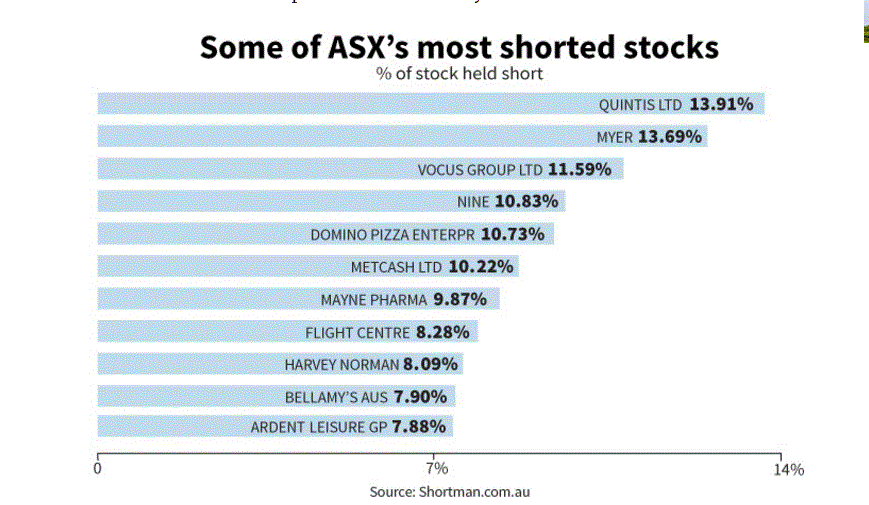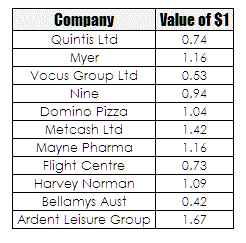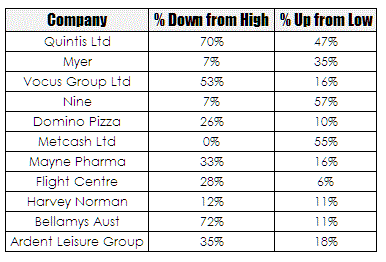This article is apparently doing the rounds and it purports to look at the supposedly new development of predatory short selling and uses the attack on Quintix by the US group Galucus as proof of this and along the way we get the usual dose of perceived wisdom from Gerry Harvey. Whenever such a piece on short selling appears it is predicated on a few basic assumptions.
- Short sellers drive down the price of instruments thereby engaging in a form of pseudo market manipulation
- Short sellers tend to target decent businesses and decent people and are therefore un-Australian
- Short sellers know what they are doing and are always profitable.
- Knowing which stocks are being shorted will give you an edge.
- Predatory short selling is a new development.
The article identifies a series of stocks that are among the most shorted on the ASX and I have reproduced this list below since it gives me a starting point for looking at some of the actual data surrounding these stocks.
What I wanted to look at was some of the performance figures that you might derive from shorting these stocks. The first thing I did was assume that exactly one year ago 1 shorted $1 of each of these stocks. I then valued these stocks as of last nights close and generated the following table.
The current value of this basket of stocks is $10.9, so in a year I have made $0.10, if I had simply bought the index and held it passively for the same period I would have made $0.11. Speculation has to be worth the effort, particularly speculation such as short selling that exposes you to substantial risks and can be regulatory and management nightmare. However, this sort of comparison is unfair since short selling is a trading strategy – it requires active management. So it would be more appropriate to look at the peak to trough movements in these stocks over the past year and this is what the table below tracks.
As can be seen some of these stocks have had substantial movements in the past year and there are only three where movement to the upside outpaces the move down. Interestingly, as a statistical fluke the average gain and average loss sits at 31%. From a trading perspective there always needs to be a recognition that stock prices move in both directions – unfortunately for passive investors fund managers only seem to accept that stocks prices move up. The value of short sellers is the knowledge that markets move in both directions and that this provides an opportunity for profit. However, this raises the additional question of whether short selling has both an influence on price and is utilized to make a profit. For this to occur large short selling positions need to be put in place whilst the stock is stagnant and then used to drive prices down. Therefore we should see an increase in the number of shorts before a stock falls and for this number to accelerate as pressure was brought to bear. To test this assumption I looked at some charts from the Shortman.com.au site which is used as the basis for the first graph in this piece and I have reproduced them below.
To be honest I am buggered if I can see a relationship between the lift on the number of short sellers and a decline in price. What I see is a mixed bag of short sellers being late, being early, not being there at all and getting lucky. Granted using the old Mark 1 eyeball is a dangerous thing and I cant extract the data to look at the true correlation between short sellers and price. But if it isn’t obvious then crunching it statistically to find some form of relationship isn’t reliable. So we come back to the basic questions I posed above and it is worth summarising an answer to each –
Short sellers drive down the price of instruments thereby engaging in a form of pseudo market manipulation
Not from what I can see. In fact if anything short selling is a boon to the market since it aids in liquidity, price discovery and as ASIC found much to its chagrin during the GFC it dampens volatility.
Short sellers tend to target decent businesses and decent people and are therefore un-Australian
People who complain about short selling fail to understand the basic mechanics of all trading is to elicit price discovery. The marekt then votes on its future view of this discovery – markets look forward not nackswards. So when you see the price of groups such as HVN get the wobbles it is the market voting about what it perceives to be the future prospects of this company in light of changes in technology, consumer bahvious and competition.
Short sellers know what they are doing and are always profitable.
Not from what I have seen
Knowing which stocks are being shorted will give you an edge.
See above – also consider the most you can make is 100% and that is functionally impossible. Simply Google best performing stocks of 2016 and this will give you an idea of the side of the market you want to be on.
Predatory short selling is a new development.
From my historical perspective I would say that short selling now is harder than it used to be. There are restrictions on naked short selling and the settlement system we operate under makes it hard to game the system. Back in the day when we had 14 day settlement you could short sell a company and buy it back before settlement and if you were careful no one was any the wiser. With instantaneous settlement this is actually very hard to get away with. As I said from a simple back office perspective short selling equities is a pain in the arse.










No idea WTFuss is about –
#1 Currency Pairs – One has to be sold. Simple as that!
#2 Brokers use shorting all the time in building opposing (synthetic) portfolios to maintain delta neutral. Sales people paid commissions (I think we all know this).
#3 People and banks do it every day. You buy a house that you don’t own with money you don’t have (paying a substantial fee (interest) as you slowly buy back your position from the bank!
#4 No one would willingly short a rapidly growing stock also at the risk of paying Div. Properly managed companies are simply not shortable (not for profit).
#5 Shorts need to be closed out eventually. No one complains about all of the ‘buy stops’ propping up and stalling an otherwise plunging market price.
#6 If enough intelligent traders identify enough profitable shorts during a broader market correction, they then have more capital to ply into the markets cheaper stocks at the end of it to help rebuild the market.
#7 CEO’s; manage your companies as best you can. Do your job! No one will look to short (you?), for possible profit.
#8 If you think “shorting” is going to detract from your “Mark to Market” value of your company, then that makes your stock a BUY! More BUYERS can get in at reasonable price.
#9 Buying short priced futures is shorting? Seriously!?
#10 —————— Fill in the blanks!
( I think Problems arise when creditors ‘clause’ Mark to Market values ). BNB.
(If interested)
[There’s an old article on ‘Investopedia’ called “Questioning The Virtue of a Short Sale”
V